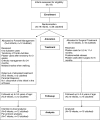Comparison of Ponseti versus surgical treatment for idiopathic clubfoot: a short-term preliminary report
- PMID: 19350335
- PMCID: PMC2745452
- DOI: 10.1007/s11999-009-0819-5
Comparison of Ponseti versus surgical treatment for idiopathic clubfoot: a short-term preliminary report
Abstract
The Ponseti method of treatment for congenital clubfeet has gained widespread clinical acceptance. We have used manipulation, serial casting, and surgery to treat congenital clubfeet for almost 3 decades. Considering the Ponseti method of treatment to replace our traditional treatment method, we conducted a randomized, controlled trial evaluating the short-term outcome of the two treatment protocols. We evaluated foot function and applied a standardized measure of health status for children with orthopaedic problems. Nineteen patients (28 feet) were included in the trial. Nine infants (12 feet) were assigned to the Ponseti treatment group, and 10 (16 feet) were assigned to a group with initial casting and posteromedial release at the age of 6 to 8 months. The minimum followup was 3.3 years (mean, 3.5 years; range 3.3-3.8 years). Outcome measures included the Functional Rating System of Laaveg and Ponseti, the Pediatric Outcomes Data Collection Instrument (PODCI), and standardized radiographic measurements. At last followup the mean Functional Rating score was higher in the Ponseti group. Passive dorsiflexion and passive inversion-eversion were better in the Ponseti group. PODCI scales were comparable and radiographic outcome measures were similar in both groups. This trial has documented a favorable short-term outcome for the Ponseti method when compared with a traditional treatment protocol.
Level of evidence: Level III, therapeutic study. See the Guidelines for Authors for a complete description of levels of evidence.
References
-
- {'text': '', 'ref_index': 1, 'ids': [{'type': 'PubMed', 'value': '2023786', 'is_inner': True, 'url': 'https://pubmed.ncbi.nlm.nih.gov/2023786/'}]}
- Atar D, Lehman WB, Grant AD. Complications in clubfoot surgery. Orthop Rev. 1991;20:233–239. - PubMed
-
- {'text': '', 'ref_index': 1, 'ids': [{'type': 'DOI', 'value': '10.1097/01.blo.0000201147.12292.6b', 'is_inner': False, 'url': 'https://doi.org/10.1097/01.blo.0000201147.12292.6b'}, {'type': 'PubMed', 'value': '16456307', 'is_inner': True, 'url': 'https://pubmed.ncbi.nlm.nih.gov/16456307/'}]}
- Bor N, Herzenberg JE, Frick SL. Ponseti management of clubfoot in older infants. Clin Orthop Relat Res. 2006;444:224–228. - PubMed
-
- {'text': '', 'ref_index': 1, 'ids': [{'type': 'PubMed', 'value': '14360326', 'is_inner': True, 'url': 'https://pubmed.ncbi.nlm.nih.gov/14360326/'}]}
- Bösch J. [Biological fundamentals of conservative therapy of clubfoot] [in German]. Z Orthop Ihre Grenzgeb. 1954;85:429–448. - PubMed
-
- {'text': '', 'ref_index': 1, 'ids': [{'type': 'PubMed', 'value': '643263', 'is_inner': True, 'url': 'https://pubmed.ncbi.nlm.nih.gov/643263/'}]}
- Carroll NC, McMurtry R, Leete SF. The pathoanatomy of congenital clubfoot. Orthop Clin North Am. 1978;9:225–232. - PubMed
-
- {'text': '', 'ref_index': 1, 'ids': [{'type': 'DOI', 'value': '10.1007/s00402-006-0267-6', 'is_inner': False, 'url': 'https://doi.org/10.1007/s00402-006-0267-6'}, {'type': 'PubMed', 'value': '17216170', 'is_inner': True, 'url': 'https://pubmed.ncbi.nlm.nih.gov/17216170/'}]}
- Changulani M, Garg N, Bruce CE. Neurovascular complications following percutaneous tendoachillis tenotomy for congenital idiopathic clubfoot. Arch Orthop Trauma Surg. 2007;127:429–430. - PubMed
Publication types
MeSH terms
LinkOut - more resources
Full Text Sources
Research Materials


